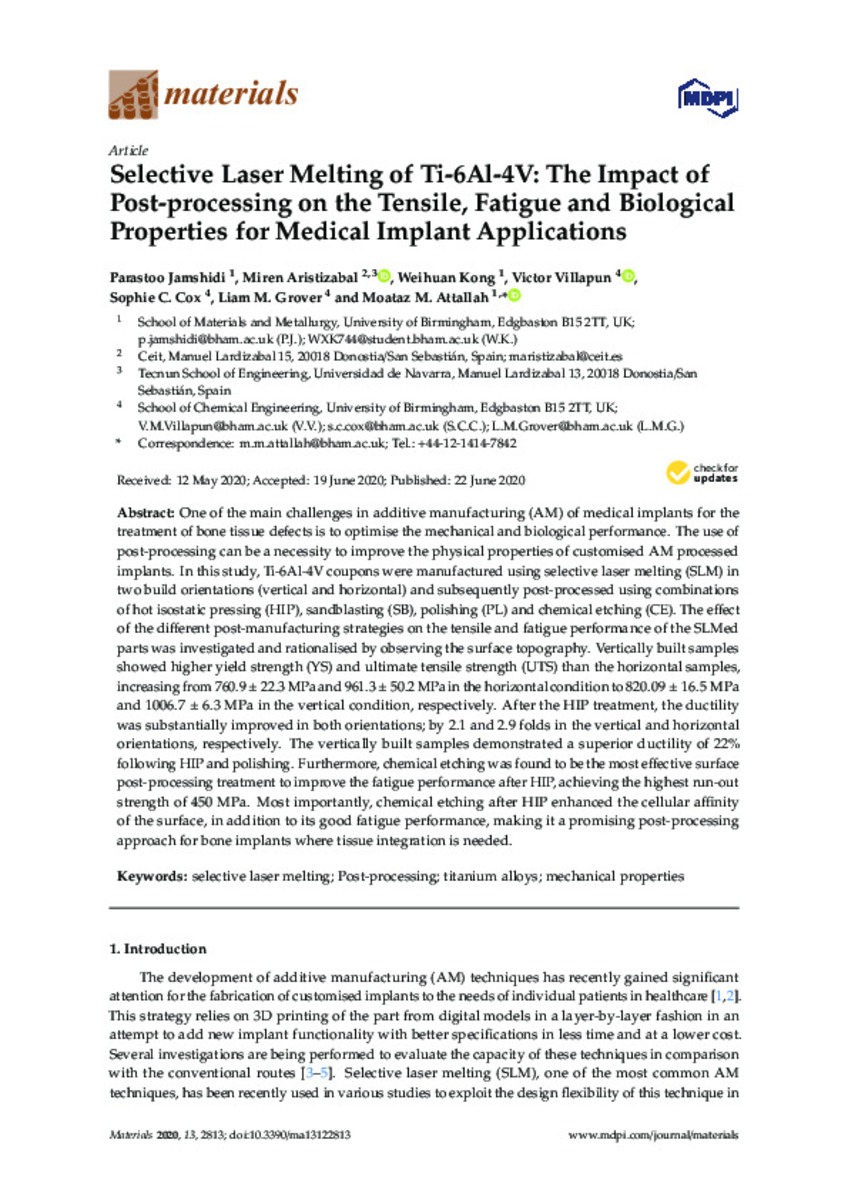Full metadata record
| DC Field | Value | Language |
|---|---|---|
| dc.creator | Jamshidi, P. (Parastoo) | - |
| dc.creator | Aristizabal, M. (M.) | - |
| dc.creator | Kong, W. (Weihuan) | - |
| dc.creator | Villapun, V. (Victor) | - |
| dc.creator | Cox, S.C. (Sophie C.) | - |
| dc.creator | Grover, L.M. (Liam M.) | - |
| dc.creator | Attallah, M.M. (M. M.) | - |
| dc.date.accessioned | 2023-06-05T10:51:41Z | - |
| dc.date.available | 2023-06-05T10:51:41Z | - |
| dc.date.issued | 2020 | - |
| dc.identifier.citation | Jamshidi, P. (Parastoo); Aristizabal, M. (M.); Kong, W. (Weihuan); et al. "Selective laser melting of Ti-6Al-4V: The impact of post-processing on the tensile, fatigue and biological properties for medical implant applications". Materials. 13 (12), 2020, | es |
| dc.identifier.issn | 1996-1944 | - |
| dc.identifier.uri | https://hdl.handle.net/10171/66546 | - |
| dc.description.abstract | One of the main challenges in additive manufacturing (AM) of medical implants for the treatment of bone tissue defects is to optimise the mechanical and biological performance. The use of post-processing can be a necessity to improve the physical properties of customised AM processed implants. In this study, Ti-6Al-4V coupons were manufactured using selective laser melting (SLM) in two build orientations (vertical and horizontal) and subsequently post-processed using combinations of hot isostatic pressing (HIP), sandblasting (SB), polishing (PL) and chemical etching (CE). The effect of the different post-manufacturing strategies on the tensile and fatigue performance of the SLMed parts was investigated and rationalised by observing the surface topography. Vertically built samples showed higher yield strength (YS) and ultimate tensile strength (UTS) than the horizontal samples, increasing from 760.9 ± 22.3 MPa and 961.3 ± 50.2 MPa in the horizontal condition to 820.09 ± 16.5 MPa and 1006.7 ± 6.3 MPa in the vertical condition, respectively. After the HIP treatment, the ductility was substantially improved in both orientations; by 2.1 and 2.9 folds in the vertical and horizontal orientations, respectively. The vertically built samples demonstrated a superior ductility of 22% following HIP and polishing. Furthermore, chemical etching was found to be the most effective surface post-processing treatment to improve the fatigue performance after HIP, achieving the highest run-out strength of 450 MPa. Most importantly, chemical etching after HIP enhanced the cellular affinity of the surface, in addition to its good fatigue performance, making it a promising post-processing approach for bone implants where tissue integration is needed. | es_ES |
| dc.description.sponsorship | The authors would like to acknowledge the Engineering and Physical Sciences Research Council (grant number EP/L020815/1) for funding this research. MA and WK would like to acknowledge the financial support by the Guangdong Academy of Sciences (contract 17-0551). | es_ES |
| dc.language.iso | eng | es_ES |
| dc.publisher | MDPI AG | es_ES |
| dc.rights | info:eu-repo/semantics/openAccess | es_ES |
| dc.subject | Selective laser melting | es_ES |
| dc.subject | Post-processing | es_ES |
| dc.subject | Titanium alloys | es_ES |
| dc.subject | Mechanical properties | es_ES |
| dc.title | Selective laser melting of Ti-6Al-4V: The impact of post-processing on the tensile, fatigue and biological properties for medical implant applications | es_ES |
| dc.type | info:eu-repo/semantics/article | es_ES |
| dc.description.note | This article is an open access article distributed under the terms and conditions of the Creative Commons Attribution (CC BY) license (http://creativecommons.org/licenses/by/4.0/). | es_ES |
| dc.identifier.doi | 10.3390/ma13122813 | - |
| dadun.citation.number | 12 | es_ES |
| dadun.citation.publicationName | Materials | es_ES |
| dadun.citation.volume | 13 | es_ES |
| dc.identifier.pmid | 32580477 | - |
Files in This Item:
Statistics and impact
Items in Dadun are protected by copyright, with all rights reserved, unless otherwise indicated.






